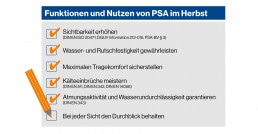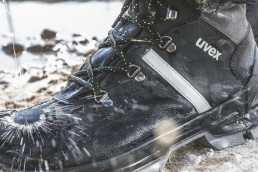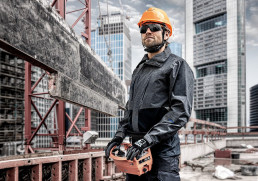The days are getting shorter, the weather has turned cool and more often than not fog hinders visibility. In this post, we explain what this means for your choice of PPE and which standards relating to PPE you should be aware of.

Cold, wind and wet conditions – these three factors pose a major challenge for workers in the transition between seasons. Temperatures are already quite low, especially in the mornings and evenings. The result: surfaces can be slippery or even muddy. Anyone who works outdoors should be particularly careful. After all, without adequate protection, cold and wet conditions can quickly lead to a cold or even to more long-term consequences for your health. So the question is, which PPE components are essential in autumn?
Important PPE components for autumn
It’s a fact: occupational safety in autumn has to meet different requirements to those in the warmer seasons. Those responsible for PPE should therefore adapt the PPE in their workplace to the changing temperatures and precipitation at an early stage.
First things first: there is no single solution for which clothing to choose. The place, conditions and type of work activity all play a crucial role. However, as a minimum, the following PPE elements are generally recommended for work activities in autumn:
- Insulated trousers or dungarees
- Standard-compliant high-visibility jackets in accordance with DIN EN ISO 20471
- Waterproof jackets or overalls
- Gloves
- Waterproof safety shoes
In addition to these six general categories, certain work activities may also require additional PPE items for respiratory, hearing or head protection. The question remains: as the person responsible for PPE, how do you find the right protective clothing for your workplace and which factors play a role in autumn?
Tip 1: Increase your visibility
Whether in fog or approaching darkness: if your colleagues’ activities require standard-compliant high-visibility protection, appropriate high-visibility clothing that complies with DIN EN ISO 20471 must be worn. This clothing provides the 360° visibility required by law and is especially recommended in autumn and winter. The German Social Accident Insurance (DGUV) Information 212-016 provides clear guidance on the requirements for high-visibility clothing and its use when working outdoors and on construction sites.
Additional guidelines regarding, for example, colour or the required warning class of the clothing depend on the individual workplace. In accordance with Section 3 of the PPE Usage Ordinance, employers are also obligated to explain to their workers how to use the equipment correctly.
The subject of visibility is particularly important when working on busy roads. But it is also recommended to fall back on neon yellow or orange high-visibility jackets and trousers when working in poor lighting conditions on construction sites and in warehouses.
What you need to know: DIN EN ISO 20471 identifies three classes of clothing (1, 2, 3), which differ with regards to the minimum amount of fluorescent background material and reflective material required. Depending on the required protective class, reflective strips and fluorescent outer fabrics encircle the torso, trouser legs and sleeves more or less completely.
Attention: you should pay particular attention to the cleaning and care of standard-compliant high-visibility clothing to ensure the reflective strips are not damaged. The intact reflective material must not go below the required amount.
Tip 2: Pay attention to water and slip resistance
The right footwear is at least as important as good visibility. After all, your feet need to stay dry in the often rainy days of autumn. Thanks to their high-quality membrane technologies, breathable and waterproof materials like Gore-Tex (Teflon) ensure that foot perspiration and odours can escape from the inside of the shoe, but rain and other moisture cannot penetrate the inside of the shoe from the outside. Safety shoes with a deep tread provide additional support and significantly reduce the risk of slipping.

However, wearing PPE is not the only thing you can do to stay safe and sure-footed in the workplace. It should be clear, for example, who in your company is responsible for clearing snow or disposing of wet leaves. In addition to this, you can also think about having non-slip floor coverings or at least doormats in entrance areas.
Tip 3: Ensure maximum wearer comfort
It is also, or especially, the case that in autumn, acceptance of PPE by employees is crucial. The best possible wearer comfort is a significant argument for this. Typical reasons for not wearing PPE include:
- Weather protection jackets restrict freedom of movement
- Gloves don’t fit and make gripping objects difficult
- Pull-over trousers slip off
All of this can be avoided by choosing the right clothing and shoe sizes.
Did you know?
As is the case with casual clothing, the tried-and-tested concept of layering can also be applied to PPE in the autumn. Multiple layers of clothing are worn over one another and unnecessary garments can be removed as needed. Specially designed functional undergarments like the uvex suXXeed can transport moisture outwards where it is absorbed by a warm fleece layer. The outermost clothing layer keeps moisture away from the body.
Tip 4: Protect yourself from sudden cold temperatures
Temperature changes are as much a part of autumn as colourful piles of leaves. It is therefore recommended to be prepared for all weather eventualities.
In Germany, DIN EN 342 sets out all requirements for protective clothing against the cold. It also includes test methods for the performance characteristics of clothing systems (single or two-piece garments) for protection against the cold. Clothing and PPE items that comply with DIN EN 342 are intended for use in cold environments from around minus 5 degrees and are labelled with a pictogram of an ice crystal. DIN EN 14058 is another standard that relates to clothing that provides protection in cooler environments, i.e. up to minus 5 degrees.
Generally you should differentiate between the DIN EN 511 and DIN EN 342 standards. They identify products that are both resistant to convective and contact cold and also waterproof.
Schon gewusst?…
Types of cold that PPE protects against
Convective cold: Colloquially this is also known as ‘penetrating cold’. It is caused by the movement of air. In a convection current, warm air rises and cold air sinks, leading to cold that affects nearby people and objects. This mainly affects people who spend all day in areas with low temperatures.
Contact cold: This type is relevant for workers who come into contact with cold or frozen objects. It is not only the efficiency of protective and heat-insulating PPE material layers that is important here, but also their tactility. The latter refers to the sensitivity of a PPE component in relation to the relevant work surface.
Tip 5: Use breathable clothing
In Germany, DIN EN 343 regulates all requirements for waterproof and breathable protective clothing for protection against precipitation and wet conditions. This includes rain, snowfall, fog and ground moisture. Clothing is categorised into Classes 1, 2 or 3 depending on its water impermeability and breathability. A higher class indicates better protection against moisture as well as more efficient outward transportation of moisture. Especially in autumn, you should look out for professional equipment that warms up the body and ensures a healthy body temperature.
For example, fleece jackets are a good choice in dry weather because they are soft, warm and light, whereas in wet and cold temperatures, softshell jackets provide better protection and are also very comfortable to wear.

Tip 6: Keep a clear view
Lenses fogging up is an annoying problem, especially in misty autumn months. Wearing a face mask often exacerbates the issue. Specially designed glasses cloths such as the uvex antifog cloth, which can be used multiple times, provide relief. If this is too time-consuming, you can also try uvex ultravision goggles with anti-fog coating on the inside.
Eye protection is a topic that is often neglected. As the person responsible for PPE in your area of activity, you should definitely pay attention to safety spectacles that are appropriate for different weather conditions. Adequate anti-fog protection is particularly important when employees regularly move from indoors to outdoors while working – but also during physically demanding activities, for example. The combination of fog or snow and sun also poses significant health risks for the eyes. Individually adapted and tinted lenses are of particular importance here. Why not try our uvex lens tinting advisor this autumn?
Tip 7: Check your protective clothing
PPE only provides its full protection if it is undamaged. For this reason, jackets, for example, should be checked regularly to make sure that all coatings are still intact. It is also a good idea to pay attention to seams and any exposed parts. You should also check if re-proofing is necessary to ensure the item is fully protected against the wind and weather.
Our blog post ‘7 mistakes that you should definitely avoid when it comes to PPE’ provides more detail on further aspects of checking and maintaining your PPE.
How to find the right PPE for autumn
uvex provides innovative PPE products to protect the eyes, body, hearing and feet for every season. Discover our product ranges now and find the right PPE for your workplace.
Do you want to get your PPE ready for winter as well? Then our comprehensive range of PPE products for the colder days could be just right for you. We hope you enjoy browsing!